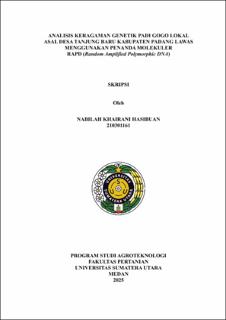Analisis Keragaman Genetik Padi Gogo Lokal Asal Desa Tanjung Baru Kabupaten Padang Lawas Menggunakan Penanda Molekuler RAPD (Random Amplified Polymorphic DNA)
Genetic Diversity Analysis of Local Gogo Rice from Tanjung Baru Village, Padang Lawas Regency Using RAPD (Random Amplified Polymorphic DNA) Molecular Markers

Date
2025Author
Hasibuan, Nabilah Khairani
Advisor(s)
Wahyuni, Hafnes
Metadata
Show full item recordAbstract
Gogo rice is one of the rice cultivars on dryland that has an important role
in the agricultural system of the Indonesian people. The local gogo rice cultivar
of Padang Lawas Regency has been abandoned by many farmers because of the
use of national superior varieties and has many shortcomings. However, through
the use of RAPD molecular markers, it is hoped that it can identify superior traits
in the gogo rice plant so that its genetic potential can be increased. This study
aims to determine the genetic diversity and kinship relationship of gogo rice from
Padang Lawas Regency based on the molecular marker RAPD (Random
Amplified Polymorphic DNA). This research was conducted at the Plant
Biotechnology Laboratory, Faculty of Agriculture, University of Sumatera Utara
from January to May 2025. The genetic material used in this study is 8 local gogo
rice cultivars from exploration. The samples were isolated and amplified using 6
RAPD primers, namely OPB 7, OPC 19, OPD 2, OPD 8, OPD 11 and OPD 13.
Tape length was determined using UVITEC Cambridge FireReader software with
sizes varying between 243-1454 bp. Cluster analysis using the UPGMA method
and PCoA analysis using MVSP ver. 3.2 software. Based on PCoA analysis, there
was 1 sample that spread, namely Siluka cultivar. The amplification results with 6
RAPD primers resulted in a polymorphic band percentage of 92%. The results of
cluster analysis showed that 8 cultivars were divided into 2 main groups with a
coefficient of similarity of 0,45 – 1. The Sikak Hijau and Sidawat cultivars have
the most genetic kinship based on 6 RAPD primers with a similarity value of 0,30.
Collections
- Undergraduate Theses [3569]
